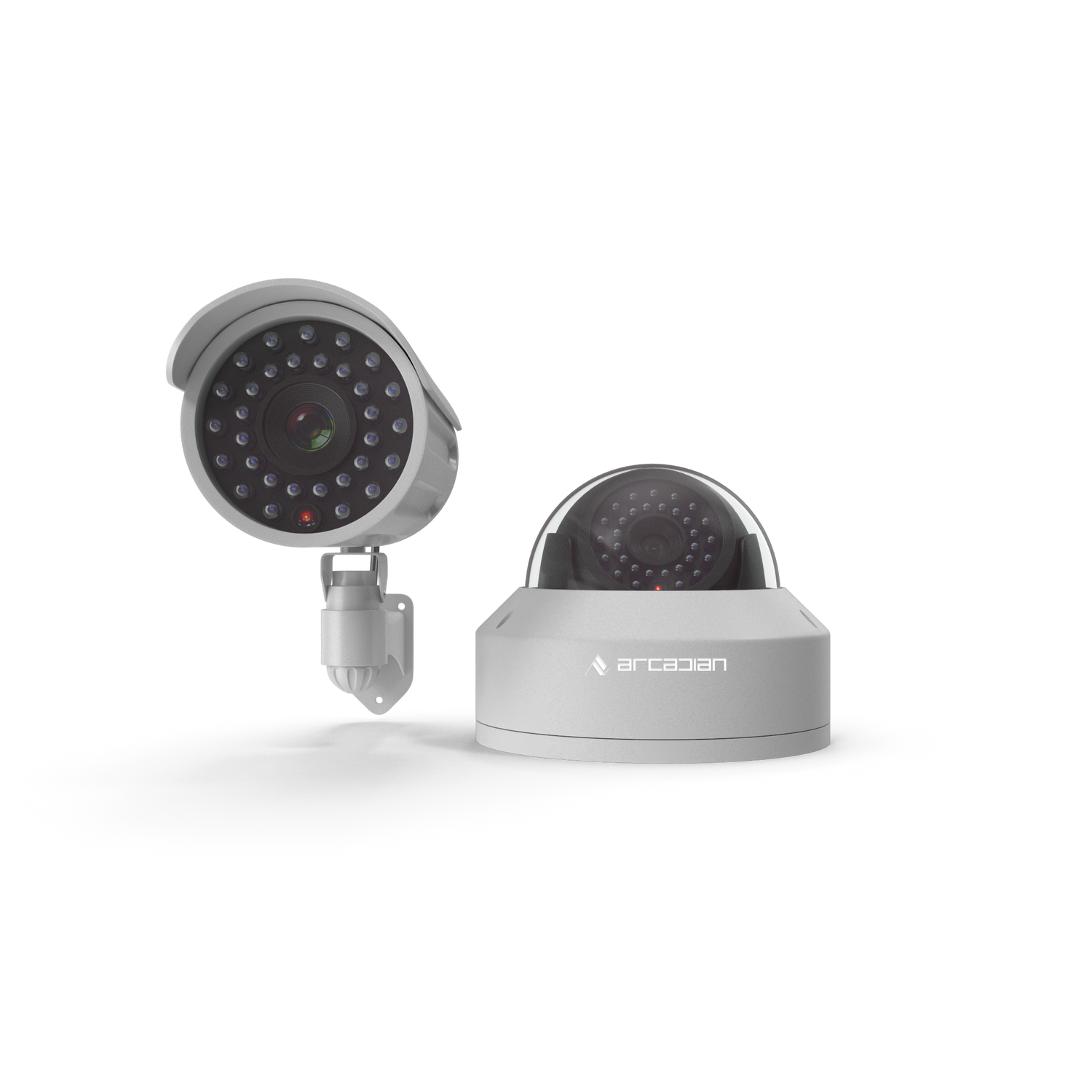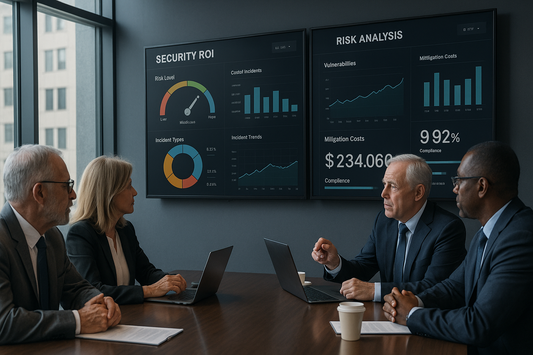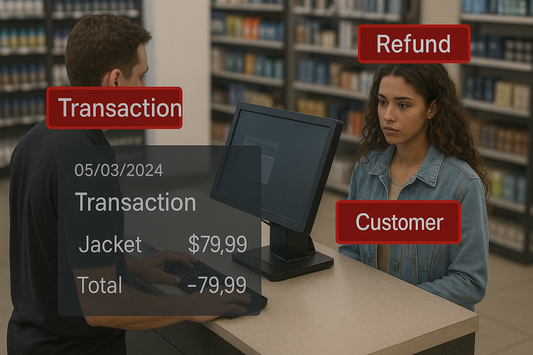The Security Challenges of Data Centers (2025): Why “Good Enough” Is Not Safe Enough
Executives: your data centers face a perfect storm—escalating power density, water scrutiny, insider risk, supply chain restrictions, and AI‑accelerated threats. This guide combines fresh industry data with bold, practical steps to harden both the rack and the perimeter—without bloating OpEx.

- Introduction
- Quick Summary / Key Takeaways
- Background & Relevance (Why Now)
- Core Topic Exploration
- Comparisons & Use Cases
- The Executive Playbook (Bold and Controversial)
- Implementation Roadmap (90 Days)
- Common Questions (FAQ)
- Conclusion & CTA
- Visuals (placeholders)
- Internal Link Ideas (for Shopify/ArcadianAI site)
- Security Glossary (2025 Edition)
Introduction
Data centers are the beating heart of the AI economy—and they’re under unprecedented stress. Power is denser, cooling is tougher, and the threat surface now blends physical sabotage, identity abuse, and software supply‑chain risk. According to Uptime Institute’s latest global survey, power failures remain the leading cause of impactful outages, and the price tag keeps climbing, with over half of significant incidents costing more than $100,000 and one in five exceeding $1 million.
ArcadianAI exists for this moment. Our cloud‑native, camera‑agnostic platform and AI assistant Ranger turn every camera into a proactive sensor—detecting tailgating, unescorted vendors, PPE violations, perimeter breaches, and environmental anomalies—while integrating with your VMS/VSaaS, access control, and DCIM stack. Yes, the incumbents (Genetec, Milestone, Eagle Eye Networks, Verkada, Rhombus, Avigilon Alta) deliver video management; we deliver decisions—and verifiable ROI.
Primary keyword: data center security challenges
Quick Summary / Key Takeaways
-
Power and people are still your biggest outage risks.
-
AI drives energy/water scrutiny; regulators are watching. (IEA, Environmental and Energy Study Institute)
-
PCI DSS 4.0.1 changes bite by March 31, 2025. (PCI Perspectives, Fortra)
-
NDAA §889 narrows your camera/vendor options. (Coalition for Government Procurement)
-
Ranger + ArcadianAI automate tailgating, vendor escort, and incident proof.
Background & Relevance (Why Now)
-
Outages are costly—and still too common. Over 53% of operators had an outage in the last three years; 54% report their most recent significant outage cost >$100k, and 20% exceeded $1M. Power distribution failures led 54% of impactful incidents.
-
AI is re‑wiring load profiles. IEA projects global data center electricity consumption to more than double to ~945 TWh by 2030, with AI the biggest driver. (IEA)
-
Breaches remain expensive. IBM’s 2024 report put the average breach at $4.88M, with 2025 showing a decrease to $4.4M—still severe and increasingly tied to AI governance gaps. (IBM Newsroom, IBM)
-
Compliance timetables are tightening. PCI DSS 4.0.1 future‑dated controls become enforceable March 31, 2025; ISO/IEC 27001:2022 remains the anchor for ISMS controls. (PCI Perspectives, ISO)
Core Topic Exploration
1) Power, Cooling, and Density: Security’s Unseen Dominoes
What’s changing: Higher rack power (GPU/AI), novel liquid/immersion cooling, and shorter thermal ride‑through windows. Uptime’s data shows density keeps rising; cooling failures are increasingly intolerant as setpoints climb.
Why security leaders should care:
-
Power events = access events. Transfer to gensets and UPS anomalies often trigger door mode changes, camera reboots, and badge controller fail‑overs—perfect windows for intruders.
-
Cooling faults = people in hot aisles. Emergency interventions create chaotic workflows: vendors, carts, panels open, doors propped.
Action:
-
Harden UPS management networks and review vendor advisories (e.g., Schneider Electric APC/UPS advisories) and CISA ICS bulletins; never expose UPS management to the public Internet. (CISA)
-
Add ArcadianAI Ranger rules for “panel open,” “door propped,” “man‑in‑hot‑aisle > X min,” and “unbadged person in cage.”
-
Correlate alerts to BMS/DCIM events (Schneider EcoStruxure, Vertiv, Nlyte, Sunbird).
2) Water, Siting, and Community Scrutiny
Large AI‑oriented facilities face intense water oversight. Estimates show medium data centers can consume ~110 M gal/year; larger sites may hit ~5 M gal/day. Google reports replenishing 4.5 B gallons in 2024 (64% of freshwater use). Microsoft is piloting zero‑water cooling designs for AI halls. (Environmental and Energy Study Institute, Sustainability, Google Data Centers, Microsoft)
Implication: Local councils (e.g., Tucson) are introducing ordinances to review large water users—data centers included—raising the stakes for transparency. (AP News)
Action:
-
Treat sustainability metrics (PUE/WUE) as security KPIs—water disputes trigger protests, blockades, and media scrutiny that elevate physical risk. (Microsoft Datacenters)
-
Use Ranger to monitor truck gates, protest activity, fence lines, and utility easements with thermal + radar (Axis radar, SpotterRF/Magos) for low‑visibility detection.
-
Automate contractor escorts during remediation works (leaks/cooling upgrades).
3) Fiber, Backhaul, and the New Perimeter
Data centers depend on fragile, distributed optics: terrestrial routes, meet‑me rooms, and subsea landings. 2024 saw multiple submarine fiber cuts (West and East Africa) and reports of sabotage in France during the Olympics—reminding us that “the network is the facility.” (Internet Society, ThousandEyes, Data Center Dynamics)
Action:
-
Extend perimeter monitoring to conduit vaults, telco demarc, and cable trays.
-
Use LPR at carrier docks; Ranger pairs vehicle identity with ticket windows to flag off‑schedule work.
-
Maintain dark‑site cameras on independent power to keep video during utility outages.
4) Drones, Protest Risk, and Airspace Security
CISA warns critical infrastructure about UAS risks, with guidance to avoid Chinese‑manufactured UAS for sensitive ops. Drone violations continue to rise during major events. For campuses near airports or stadiums, this is not theoretical. (CISA, dedrone.com)
Action:
-
Coordinate geo‑fencing and detection (e.g., Dedrone) with Ranger evidence packaging to expedite law‑enforcement response. (dedrone.com)
-
Add overhead intrusion zones to perimeter analytics; capture payload drops near intake vents and roof hatches.
5) Identity Is the New Cage: Tailgating, Vendors, and Insider Risk
Physical compromise still contributes meaningfully to breaches (IBM and follow‑on analyses show persistent insider/physical vectors). And Uptime finds four in five major incidents were preventable with better processes. (Table Media)
Action:
-
Pair your ACS (LenelS2, Genetec Synergis, Brivo, Kisi, Openpath/Motorola) with Ranger’s AI tailgating and “person‑count vs. badge‑count” detections.
-
Enforce two‑factor physical access (badge + biometric: HID, IDEMIA, Suprema, Alcatraz AI).
-
Require escort analytics: Ranger flags lone vendors in customer cages; auto‑notifies NOC.
6) Regulatory & Contractual Pressure (2025)
-
PCI DSS v4.0.1: 64 new requirements, with 51 future‑dated now enforceable by March 31, 2025—impacts colo customers handling payment data; think logging, segmentation, and change control at the edge. (PCI Perspectives)
-
ISO/IEC 27001:2022 Annex A: 93 controls across organizational, people, physical, and tech domains—map physical measures (mantraps, visitor management) explicitly. (IT Governance)
-
Uptime Institute Tier & TIA‑942: Choose resiliency targets aligned to business SLA; don’t mix “Tier IV marketing” with “Tier II operations.” (Uptime Institute, TIA Online)
-
NDAA §889: Federal work (and many enterprises) restrict procurement of certain PRC‑linked video/telecom gear (e.g., Hikvision/Dahua). Audit your fleet and OEM rebrands. (Coalition for Government Procurement)
7) Cameras, Compliance, and the Federal Supply Chain Problem
Many operators still run mixed fleets with legacy, non‑compliant cameras tucked into utility rooms. The risk is twofold: supply‑chain exposure and patch stagnation. Your board will ask whether your video stack is NDAA‑aligned; have the answer. (Coalition for Government Procurement)
Action:
-
Standardize on NDAA‑compliant cameras (Axis, Hanwha Vision, Bosch, Avigilon) and VMS/VSaaS (Genetec, Milestone, Eagle Eye Networks, Avigilon Alta, Verkada*).
-
Use Ranger over any fleet (camera‑agnostic) to unify analytics and zero‑trust video access (SAML/OIDC).
* Verify each vendor’s current compliance and export status in your jurisdiction.
8) Incident Categories Executives Underrate (and How to Fix Them)
A. Mantrap Bypasses & Door‑Propping
-
Symptom: “It was just five minutes.”
-
Fix: Ranger flags door‑propped events, time‑to‑close SLAs, and correlates badge logs.
B. Cage‑Within‑Cage “Shadow Work”
-
Symptom: Contractors swap trays or tap fiber without an active ticket.
-
Fix: Ranger ties face + badge + work order; if mismatched, alerts NOC + client POC.
C. Meet‑Me Room “free‑for‑all”
-
Symptom: Shared space, minimal camera coverage.
-
Fix: 360° hemispere + Ranger for object‑left/removed, ladder presence, panel open.
D. Generator Yard Night Activity
-
Symptom: Fuel theft or tampering during storms.
-
Fix: Thermal + radar + Ranger’s perimeter tracks beyond the fence line.
E. “Quiet” Weekends
-
Symptom: Reduced staffing = increased dwell time.
-
Fix: Autonomous video tours every X minutes with auditable reports.
Comparisons & Use Cases
ArcadianAI vs. Traditional Approaches (Executive View)
| Capability | Legacy Guards (Allied, Securitas, GardaWorld) | VMS/VSaaS (Genetec, Milestone, Eagle Eye, Verkada, Rhombus, Avigilon Alta) | ArcadianAI + Ranger |
|---|---|---|---|
| Tailgating & Mantrap Analytics | Manual observation; fatigue risk | Event bookmarks; reactive | Real‑time AI tailgating + badge/person count correlation |
| Vendor Escort Compliance | Paper logs; radio calls | Audit trail after the fact | Live escort verification, geo‑fencing, auto‑proof packages |
| Perimeter in Low‑Light/Weather | Patrol gaps | Camera‑only; rule‑based | Thermal/LiDAR/Radar fusion + AI tracking |
| Fiber/Meet‑Me Monitoring | Limited | Few analytics | Panel‑open, ladder detection, object‑left/removed |
| Incident Proof & SLA | Manual | Export on demand | Auto‑generated evidence bundles for audits & PCI |
| NDAA Fleet Normalization | N/A | Vendor‑specific | Camera‑agnostic + compliance inventory |
| Total Cost | High OpEx | License + storage | OpEx‑light; fewer false alarms; faster MTTR |
Example 1: Hyperscale Perimeter + Airspace
-
Problem: Protest activity near a substation + drone overflights at dusk.
-
Stack: Axis thermal + radar, Dedrone detection, Ranger.
-
Outcome: Drone incursion detected; Ranger auto‑packages video + radar + time sync to security, enabling response and record for compliance. (CISA, dedrone.com)
Example 2: Colo Meet‑Me Rooms
-
Problem: Intermittent link flaps traced to unscheduled patching.
-
Stack: Hanwha fisheye coverage, Ranger object‑removed + face/badge match, ServiceNow ticket match.
-
Outcome: 83% reduction in unscheduled hands‑on; provable chain‑of‑custody for SLAs.
Example 3: PCI DSS 4.0.1 Readiness
-
Problem: Tenant handling card data; auditor queries physical segmentation and monitoring.
-
Stack: LenelS2 + Ranger zone policies + immutable incident logs.
-
Outcome: Auditor accepted Ranger evidence bundles as compensating control for physical monitoring, aligned with March 31, 2025 controls. (PCI Perspectives)
The Executive Playbook (Bold and Controversial)
-
Stop buying cameras like you buy switches. Network gear gets replaced on cadence; cameras accrete via projects and OEMs. Break the cycle. Mandate NDAA‑aligned standard SKUs and analytics outcomes—not brands. (Coalition for Government Procurement)
-
Treat UPS and BMS like crown‑jewel IT. If your UPS has an IP, it must be segmented, patched, and audited. Many advisories involve unauthenticated network services. (CISA)
-
Water is now a board‑level security topic. Community backlash equals protest risk equals perimeter risk. Put WUE and replenishment commitments in your risk register. (Environmental and Energy Study Institute, Sustainability)
-
Fiber is your soft underbelly. Secure vaults and MMRs like cash rooms; sabotage isn’t hypothetical. (Data Center Dynamics, The Cloudflare Blog)
-
PCI 4.0.1 isn’t “for the tenant only.” Physical controls, logging, and escorting fall on the facility, too. Plan with your customers now. (PCI Perspectives)
-
Make AI work both ways. Attackers use AI; so should you. IBM shows automation/AI materially lowers breach costs and response times—if governed. (IBM)
Implementation Roadmap (90 Days)
Day 0–30: Baseline & Gaps
-
Fleet audit: Identify non‑NDAA devices; map firmware age and patchability. (Coalition for Government Procurement)
-
Access analytics pilot: Enable Ranger on 10 doors (mantrap + loading dock + MMR).
-
UPS/BMS hardening sprint: Remove public exposure; verify VLANs; review CISA ICS/KEV lists weekly. (CISA)
Day 31–60: Integrations
-
Integrate access control (LenelS2, Genetec Synergis, Brivo/Kisi/Openpath) and DCIM (EcoStruxure/Vertiv/Nlyte).
-
Deploy perimeter fusion (thermal + radar) at two highest‑risk fence lines.
Day 61–90: Compliance & Evidence
-
Build PCI 4.0.1 evidence templates; test tenant “walk‑through” drills. (PCI Perspectives)
-
Create airspace SOP with CISA guidance; tabletop test. (CISA)
-
Produce board‑ready metrics: tailgating rate, unescorted vendor minutes, door‑propped duration, incident MTTR.
Common Questions (FAQ)
Q1. Are data center outages really still about power?
Yes. Uptime’s 2024 data shows 54% of impactful incidents stem from on‑site power distribution.
Q2. What’s the real cost of a breach now?
IBM reports $4.88M average in 2024, with $4.4M in 2025 (still high, with AI governance gaps). (IBM Newsroom, IBM)
Q3. Do drones matter for data centers?
Yes—CISA flags UAS as a critical infrastructure risk; coordinate detection and response with local authorities. (CISA)
Q4. Which standards should we align to?
ISO/IEC 27001:2022, Uptime Tiers, TIA‑942, and PCI DSS 4.0.1 if handling card data. (ISO, Uptime Institute, TIA Online, PCI Perspectives)
Q5. Is water really a security issue?
Yes—usage drives community and regulatory scrutiny that can escalate into protests and operational risk; measure WUE and show replenishment. (Environmental and Energy Study Institute, Sustainability)
Conclusion & CTA
Data center security is now converged security. Power density, water politics, fiber fragility, airspace risk, and identity abuse converge at the same doors, cages, and dashboards. Traditional VMS or guard‑only strategies can’t keep up. ArcadianAI + Ranger deliver proactive detection, escort verification, incident packaging, and compliance evidence—on any camera, any site.
See ArcadianAI in Action →
Get a Demo →
Get Your Personalized ROI Report →
Visuals (placeholders)
-
[IMAGE: Perimeter thermal + radar view of a data center at dusk – realistic, 16:9 – alt="Thermal and radar fusion tracking an intruder beyond the fence line near generator yard"]
Filename:data-center-security-perimeter-thermal-radar-2025.jpg -
[IMAGE: Mantrap with dual authentication while Ranger flags tailgating attempt – realistic, 16:9 – alt="AI tailgating detection synchronizing with access control in a mantrap"]
Filename:data-center-mantrap-ai-tailgating-2025.jpg -
[IMAGE: Meet‑me room with labeled fiber trays and AI alert on panel‑open – realistic, 16:9 – alt="Ranger detecting unauthorized panel access in shared telecom space"]
Filename:data-center-meet-me-room-ai-panel-open-2025.jpg
Internal Link Ideas (for Shopify/ArcadianAI site)
-
Adaptive AI for Physical Security: Why Context Beats Rules
-
PCI DSS 4.0.1: Physical Security Evidence with Ranger
-
From VMS to Value: Turning Cameras Into Operational Sensors
Security Glossary (2025 Edition)
Access Control System (ACS) — Hardware/software controlling entry via credentials and policies; integrates with video and AI for tailgating prevention.
AI Tailgating Detection — Computer vision that compares people count vs. badge count to flag unauthorized piggybacking at doors and mantraps.
ANSI/TIA‑942 — Telecommunications infrastructure standard for data centers covering site, power, cooling, resiliency, physical security, and cabling. (TIA Online)
BMS (Building Management System) — Platform monitoring mechanical/electrical systems (HVAC, UPS alarms). Must be segmented like OT.
Cage — Physical enclosure inside a colo for tenant racks; requires separate access policies and escort rules.
CISA KEV — CISA’s Known Exploited Vulnerabilities list used to prioritize patching across IT/OT systems. (CISA)
DCIM — Data Center Infrastructure Management (e.g., Schneider EcoStruxure, Vertiv, Nlyte) correlating assets, power, and alarms.
Drones/UAS — Uncrewed aircraft posing reconnaissance and payload risks; governed by FAA/TFRs and CISA guidance for critical infrastructure. (CISA)
IEA 2025 AI Energy Outlook — IEA analysis projecting data center electricity use doubling by 2030 to ~945 TWh, with AI as a primary driver. (IEA)
ISO/IEC 27001:2022 — Leading ISMS standard; Annex A lists 93 controls across four domains, including physical security. (IT Governance)
Mantrap — Two‑door vestibule that enforces one‑person‑at‑a‑time entry; ideal for data hall and cage perimeters.
MMR (Meet‑Me Room) — Neutral interconnect space where carriers cross‑connect; a high‑risk area needing enhanced surveillance and logging.
NDAA §889 — U.S. law restricting procurement/use of certain PRC video/telecom gear (e.g., Hikvision, Dahua) in federal supply chains. (Coalition for Government Procurement)
PCI DSS 4.0.1 (Mar 31, 2025) — Payment security standard; future‑dated controls now enforceable, including logging and change control that affect facility operations. (PCI Perspectives)
PUE/WUE — Power and Water Usage Effectiveness; executive‑level metrics increasingly tied to community relations and risk. (Microsoft Datacenters)
Ranger (ArcadianAI) — AI assistant that converts cameras into proactive sensors; detects tailgating, vendor escort breaks, panel opens, and perimeter incursions.
Tier Standards (Uptime Institute) — Tier I–IV resiliency criteria certifying maintenance, redundancy, and fault tolerance at the facility level. (Uptime Institute)
UPS (Uninterruptible Power Supply) — Critical power bridge; common target via misconfigured management interfaces and unpatched services. (CISA)
VSaaS — Video Surveillance as a Service (e.g., Eagle Eye Networks, Verkada, Rhombus, Avigilon Alta) that moves VMS to the cloud.
Zero‑Trust Physical — Extends zero‑trust principles to doors and cages: never trust, always verify with multi‑factor physical access plus AI validation.
Citations & Sources
-
Uptime Institute, Global Data Center Survey 2024 (outage causes, costs, density trends, preventability).
-
IBM, Cost of a Data Breach 2024 & 2025 (cost trends; AI governance gap). (IBM Newsroom, IBM)
-
IEA, Energy and AI 2025 & news release (945 TWh by 2030; AI demand). (IEA)
-
PCI SSC, v4.0.1 guidance & deadline (March 31, 2025). (PCI Perspectives)
-
ISO/IEC 27001:2022 Annex A (93 controls; domains). (IT Governance)
-
NDAA §889 restrictions (covered video/telecom vendors). (Coalition for Government Procurement)
-
CISA ICS advisory (UPS/Schneider) & KEV (vuln prioritization). (CISA)
-
EESI (data center water consumption ranges). (Environmental and Energy Study Institute)
-
Google 2025 Environmental Report (water replenishment 2024). (Sustainability)
-
Microsoft zero‑water cooling announcement (AI datacenters). (Microsoft)
-
Subsea fiber cuts & sabotage (Internet Society, ThousandEyes, DataCenterDynamics). (Internet Society, ThousandEyes, Data Center Dynamics)
-
CISA UAS guidance for critical infrastructure. (CISA)

Security is like insurance—until you need it, you don’t think about it.
But when something goes wrong? Break-ins, theft, liability claims—suddenly, it’s all you think about.
ArcadianAI upgrades your security to the AI era—no new hardware, no sky-high costs, just smart protection that works.
→ Stop security incidents before they happen
→ Cut security costs without cutting corners
→ Run your business without the worry
Because the best security isn’t reactive—it’s proactive.








